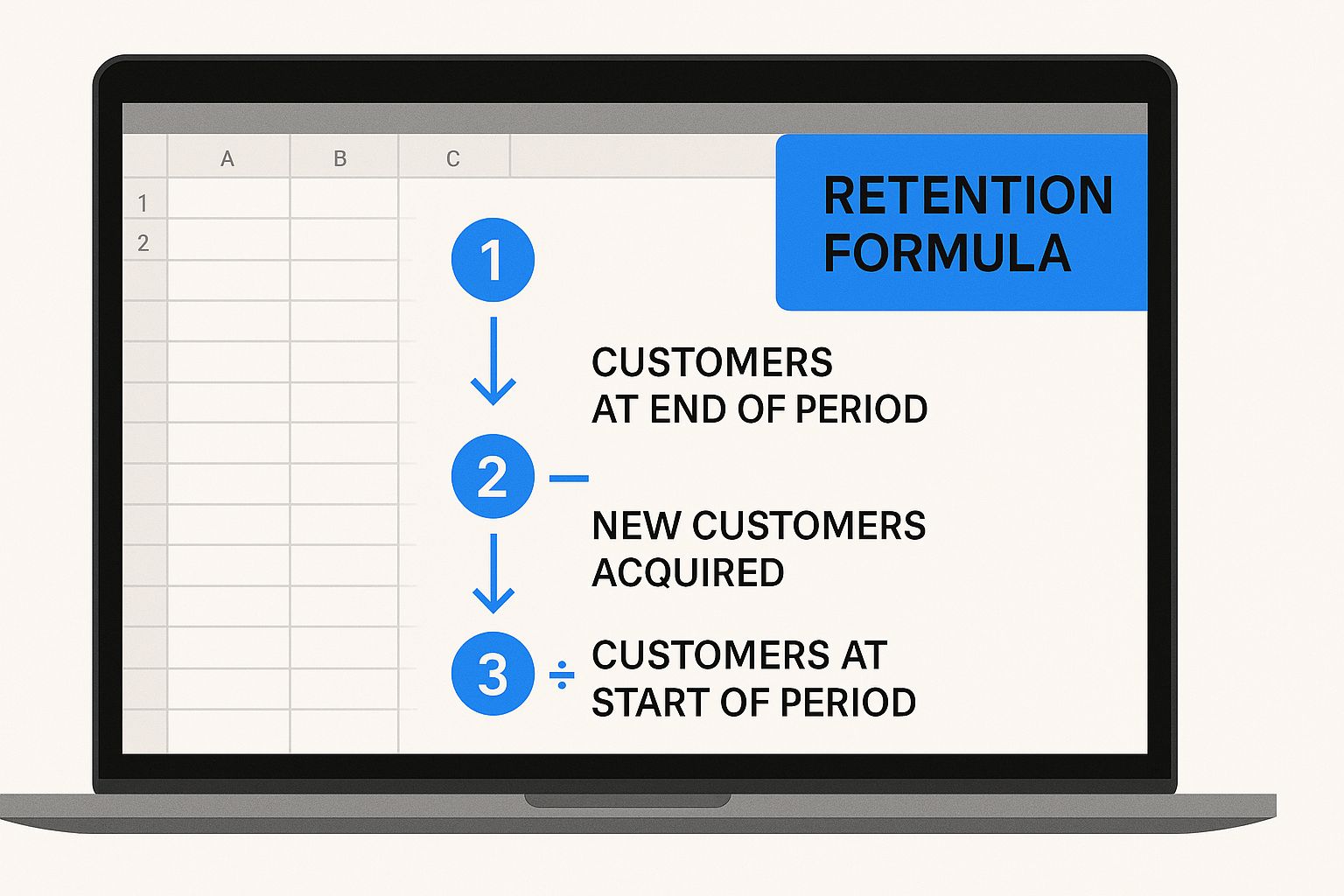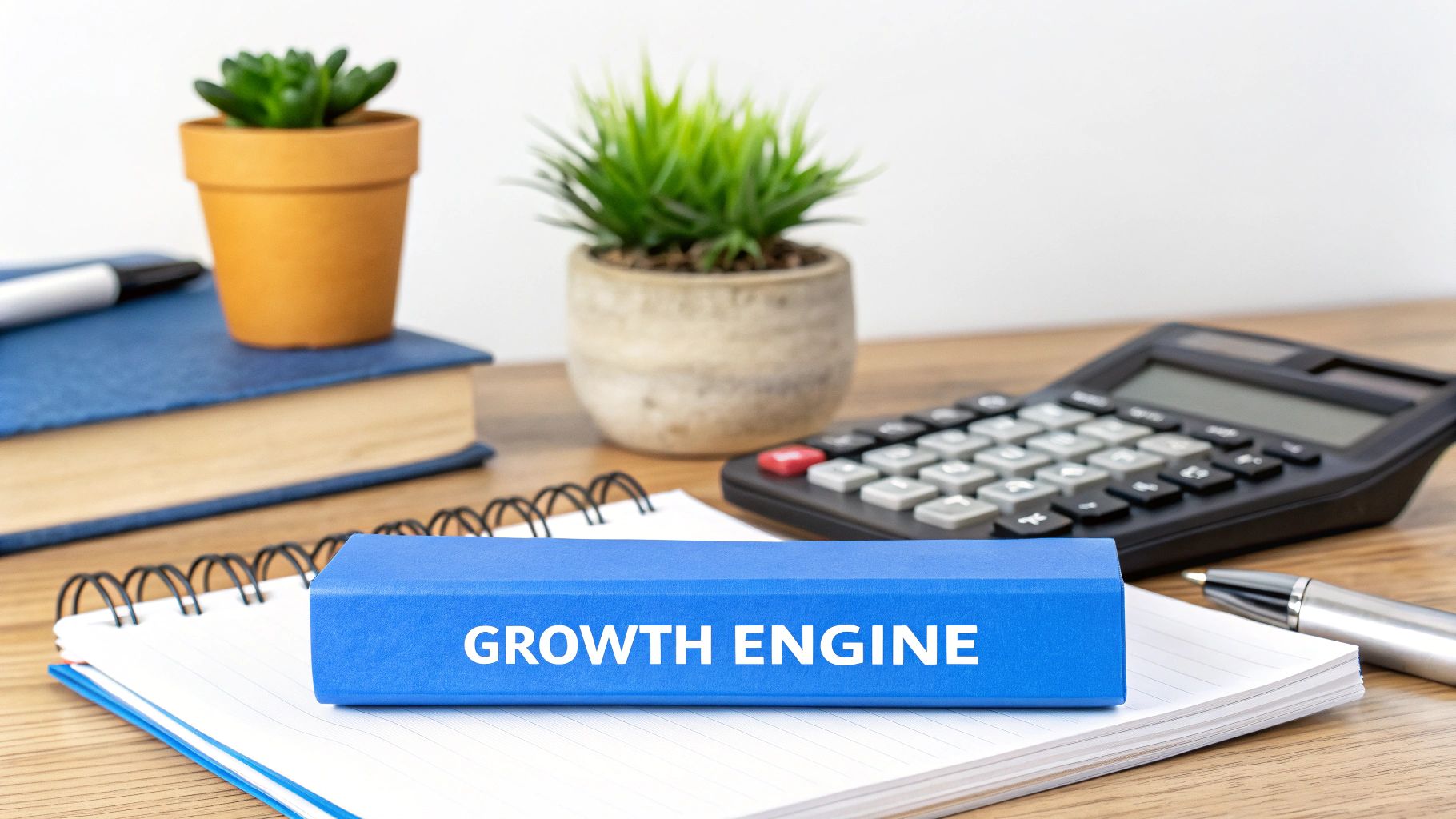Ready to figure out how many customers are actually sticking around? The formula for customer retention rate (CRR) is surprisingly simple, but incredibly powerful.
Here’s the breakdown: CRR = ((E - N) / S) × 100.
This little equation cuts through the noise and tells you the percentage of customers you held onto over a specific period. It's a direct reflection of customer loyalty and satisfaction.
At its core, the customer retention rate formula is more than just math—it's a health check for your business. It forces you to look past vanity metrics like your total customer count and focus on how well you're building relationships with people who've already bought from you. This isn't just about crunching numbers; it's about seeing the story your data is telling.
To nail the calculation, you have to get the components right.
This quick-reference table breaks down what each variable in the formula actually represents.
Think of S as your starting lineup. The goal of the formula is to see how many of those original players were still on the field at the end of the game, which is why we subtract the new players (N) from your final count (E).

This visual helps clarify that you're isolating your original customer base to get a pure, honest measure of their loyalty.
Let's walk through a real-world scenario.
Imagine a subscription box company starts Q2 with 1,000 customers. This is your S (Starting Customers). Over the next three months, they run a great marketing campaign and bring in 300 new customers (N). By the end of the quarter, their total customer count is 1,200 (E).
Now, let's plug those numbers into the formula:
Do the math, and you get a customer retention rate of 90%.
This means the company successfully kept 90% of the customers it started the quarter with. That single percentage is a direct reflection of the value and experience they're delivering month after month.
Key Takeaway: The whole point of this formula is to see who stayed. By subtracting new acquisitions, you get an unfiltered look at how many existing customers chose to stick with you. That's a powerful signal of your business's long-term health.
Of course, retention is only half the story. To get the full picture, you also need to understand its opposite. Learning how to calculate customer churn will show you the rate at which you're losing customers, giving you a complete view of your customer base dynamics.

Knowing the customer retention rate formula is one thing, but truly getting why it matters is what separates the businesses that grind it out from the ones that thrive. It’s tempting to chase the thrill of new customer acquisition—it feels like growth, right? But that's often an expensive, unpredictable game.
The real, sustainable growth engine for your business is already in your corner: your existing customers.
When you shift your focus to retention, you stop chasing one-off transactions and start building relationships. It’s dramatically cheaper to keep the customers you have than to find new ones. By some estimates, it's anywhere from 5 to 25 times cheaper. These people have already jumped the biggest hurdle—they trust you enough to have made a purchase.
Here's where the magic really happens. Small wins in retention don't just create small gains; they create massive financial returns over time. This isn’t just about saving a few bucks on your marketing spend. It’s about cranking up the lifetime value (LTV) of every single customer you manage to keep around.
A loyal customer doesn't just buy from you once. They're far more likely to:
This compounding effect is where the power lies. Research has shown again and again that boosting customer retention by just 5% can skyrocket profits by 25% to 95%. That's a staggering number, and it drives home why retention isn’t some fuzzy "nice-to-have" metric. It's a core driver of your bottom line.
Beyond the direct cash benefits, a strong retention rate fuels your most powerful and cost-effective marketing channel: word-of-mouth. Happy, long-term customers don't just stick around quietly. They become your biggest fans.
They’re the ones recommending you to friends, dropping positive reviews, and even defending your brand online.
This kind of organic marketing is pure gold because it’s built on genuine trust. A recommendation from a friend will always carry more weight than the slickest paid ad, creating a pipeline of high-quality, pre-sold leads for practically zero cost.
By focusing on the strategies that keep your customers happy, you're also building a volunteer marketing army. This is why getting a handle on the customer retention rate calculation formula is the first real step toward building a business that's more resilient, profitable, and self-sustaining.
If you're looking for actionable ways to move this needle, check out our guide on 10 proven customer retention strategies for SaaS companies.

The standard customer retention rate calculation formula is a fantastic starting point, but let’s be real—business is rarely a one-size-fits-all operation. How you define an "active customer" or a "time period" can change dramatically depending on your model. Getting the context right is everything.
This metric really took off as subscription-based models and the SaaS world exploded in the early 2000s, where tracking ongoing loyalty became the name of the game. It's a big deal because holding onto your current customers is almost always cheaper than chasing down new ones. Research from insights gathered by Bain & Company drives this point home.
So, let's break down how to apply the formula to three very different business types to make it work for you.
For a Software-as-a-Service (SaaS) business, the cadence is usually monthly. Customers are on recurring subscriptions, so it's pretty straightforward to define who is active at any given time.
Picture a project management tool. Here’s how they would crunch the numbers for their retention in April:
Now, we just plug these numbers into the formula:
CRR = ((5,400 - 750) / 5,000) x 100
The result? 93%. This tells the SaaS company they successfully held onto 93% of the customers they started the month with. It’s a clean, immediate signal of product health and customer satisfaction.
Now let's switch gears to a B2B marketing agency that operates on annual contracts. A monthly calculation here would be totally useless; their customer lifecycle is much longer. The only time frame that makes sense is yearly.
Here’s a look at their data from the last fiscal year:
The calculation is the same, just with different numbers:
CRR = ((90 - 15) / 80) x 100
Their annual retention rate comes out to 93.75%. For a business like this, looking at the annual view is the only way to get a true read on loyalty and the stability of their client base.
Expert Tip: Always align your calculation period with your customer's natural purchase or renewal cycle. If you try to run monthly numbers for an annual contract business, your data will be a mess of 100% and 0% months, completely hiding the real trend.
What about a freelance web developer who works on a project-by-project basis? This one is trickier because there's no subscription. In this case, "retention" really means a client coming back for another project within a specific timeframe.
Let’s say the freelancer decides to measure this quarterly. First, they need to define what an "active" customer from the previous period even means.
For a model like this, we can simplify the formula to focus purely on the returning cohort, since "ending customers" isn't a continuous metric.
CRR = (Number of Returning Customers / Starting Customers) x 100
CRR = (5 / 12) x 100 = 41.7%
This adapted approach gives the freelancer a super clear metric for repeat business, which is the absolute lifeblood of their operation.
So, you’ve plugged your numbers into the customer retention rate calculation formula and you've got your percentage. Great. But now for the real question: is that number any good?
An 85% retention rate might feel like a solid win, but on its own, that number is pretty much meaningless. Context is everything.
What’s considered a "good" customer retention rate isn’t some universal benchmark. It’s a moving target that shifts dramatically depending on your industry. The things that keep customers loyal in e-commerce are worlds apart from what works in the B2B SaaS space.
Comparing your rate to a generic average is a recipe for either a false sense of security or a whole lot of unnecessary panic. The only comparison that matters is how you stack up against others in your specific industry. What’s considered excellent in one sector might be a flashing red light in another.
Sure, a 100% retention rate is the dream, but it's not realistic. For most subscription-based businesses, an annual customer retention rate of around 80% or higher is a good target. But even that varies. The retail world, for example, might see average retention hover closer to 60%, while many SaaS companies are shooting for 90-95% annual retention.
If you want to dig deeper, ProfitWell has some great customer retention benchmarks that are worth checking out.
To give you a better frame of reference, here’s a look at how different industries stack up.
This table shows typical annual customer retention rates across various business sectors. Use it to get a feel for where your own results fit in.
IndustryAverage Annual Retention RateSaaS (Software-as-a-Service)85% - 95%Retail & E-commerce55% - 65%Financial Services & Insurance78% - 84%Professional Services80% - 85%Media & Entertainment75% - 82%
See what I mean? An e-commerce brand hitting a 63% retention rate is doing just fine—that's right in line with the industry average. But if a SaaS company saw that same number, they’d need to be digging into some serious churn problems.
It’s not just about your industry, though. Other factors play a huge role in what you should consider a "good" rate for your specific business. Don't overlook these details when you're setting your own goals.
When you start looking at your retention rate through the lens of your industry, business model, and how long you've been around, it stops being just a percentage. It becomes a meaningful indicator of your performance. The goal isn't just to calculate a number, but to actually understand what that number is telling you about the health of your customer relationships.
The customer retention rate formula looks simple enough on the surface, but don't let that fool you. Its simplicity hides a few common traps that can give you a completely warped view of your customer loyalty. Fall into one of these, and you could end up making strategic decisions based on bad data.
Think of it like using a miscalibrated scale—the numbers look plausible, but they aren't telling you the truth about what's really going on. Let's walk through the most common mistakes I see teams make and how to avoid them.
One of the most frequent errors is looking at all your customers as one big, happy family. A single, blended retention rate can be dangerously misleading. While that overall number might look healthy, it can easily mask serious problems brewing within specific segments of your customer base.
For instance, your overall retention rate could be a solid 85%. Awesome, right? But what if you dug a little deeper? You might discover that your high-value enterprise clients are leaving at an alarming rate, with a retention of only 60%, while your low-spend customers are sticking around at 95%.
That blended 85% rate completely hides a five-alarm fire you need to put out immediately. Without segmentation, you'd have no idea your most valuable customers are walking out the door.
Another critical misstep is choosing a measurement period that doesn't actually align with your business model. If you're a SaaS company with monthly subscriptions, you should absolutely be tracking retention on a monthly basis. Makes sense.
But if you're an e-commerce brand where customers typically buy new running shoes every six months, a monthly calculation is going to be full of useless noise. It just doesn't fit the natural buying cycle of your customers.
The key here is consistency. A huge mistake is failing to define your time period and stick to it. Whether you decide to measure monthly, quarterly, or annually, using that same interval every single time is essential for accurate trend analysis. If you don't, comparing your performance over time becomes impossible. You can learn more about how successful companies maintain data integrity from these insights on Baremetrics.
A Quick Tip: If your customers have different buying cycles, consider creating separate retention cohorts. You might track high-frequency purchasers monthly and low-frequency purchasers quarterly. This will give you a much clearer picture of how both groups are behaving.
What does an "active customer" actually mean for your business? If you don't have a crystal-clear, consistent definition, your customer retention rate calculation formula will spit out unreliable results every single time.
Does a customer count as "active" if they just log in once a month? Or do they need to complete a key action, like creating a report, making a purchase, or using a core feature?
Here are a few common definition errors to avoid:
Establishing firm rules for these scenarios isn't just about being picky—it's about ensuring the data you rely on to make critical business decisions is accurate and trustworthy.
Even with the formula in hand, a few common questions always come up when you start applying the customer retention rate calculation to your own business. Let's tackle them head-on so you can get your metrics dialed in with confidence.
Think of this section as the real-world troubleshooting guide. Getting these details right is what turns a simple number into a powerful, strategic insight.
There’s no magic number here—the right frequency is all about your business model and how often your customers typically buy from you. The key is to find a rhythm that makes sense for your customer lifecycle.
The most important rule? Consistency. Pick a timeframe that aligns with your customer behavior and stick with it. That’s the only way you can make accurate, apples-to-apples comparisons over time.
Nope. If you run the numbers with the standard formula and end up with more than 100%, it’s a red flag that something went wrong in your calculation.
The formula is specifically designed to isolate the customers you kept from your starting group by subtracting out any new customers you acquired. Because of this, the top number of the equation (E - N) can never be larger than the bottom number (S). A result over 100% almost always means one thing: you forgot to properly subtract the new customers acquired during the period.
These two metrics are just two sides of the same coin. They measure the exact same thing, just from opposite angles.
They should almost always add up to 100%. So, a 90% retention rate means you have a 10% churn rate. While they're mathematically linked, focusing on retention tends to drive a more proactive mindset centered on building loyalty. In contrast, focusing solely on churn can sometimes lead to a reactive scramble to plug leaks instead of building a better boat.
Yes, absolutely. In fact, this is probably one of the most important things you can do to get real, actionable insights from your retention data. A single, blended retention rate can be dangerously misleading.
Segmenting your customers is how you find the real story. You might discover that while your overall retention looks stable, your highest-value customers are leaving at an alarming rate, propped up by a large group of low-value, sticky customers.
By breaking down your data, you can see which groups are your most loyal advocates and which are at risk. Our guide on customer cohort analysis is a great next step for learning how to group users for these deeper insights.
Ready to move beyond spreadsheets and get a unified view of your marketing performance? Cometly combines real-time tracking with advanced analytics to show you exactly which campaigns drive your most loyal customers. See how you can eliminate wasted ad spend and scale with confidence at https://www.cometly.com.
Learn how Cometly can help you pinpoint channels driving revenue.
.svg)
Network with the top performance marketers in the industry